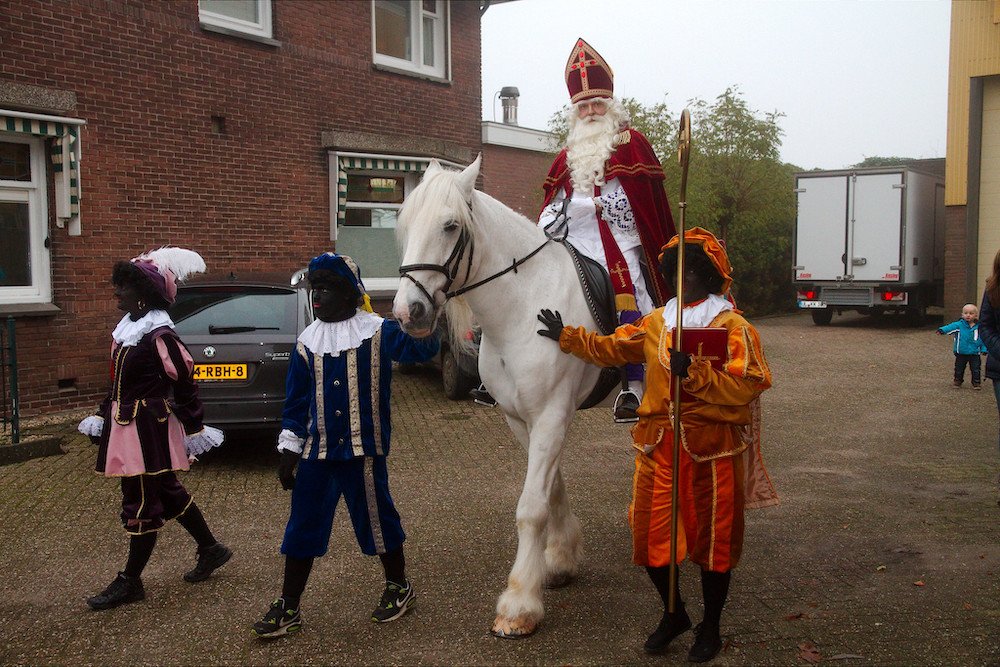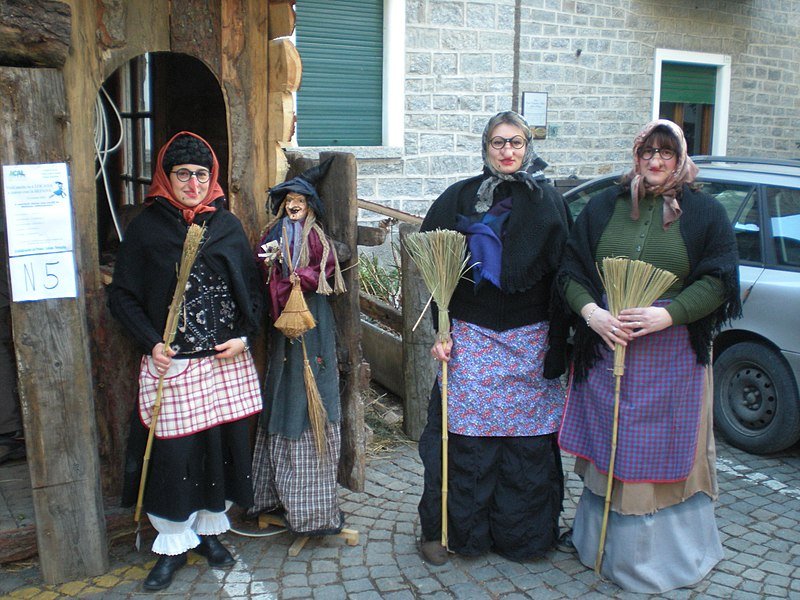5 Unique Variations Of Santa Claus Around The World
Across the globe, Santa Claus is recognized as the Christmas gift bearer. But he is not always known as a red-suited jolly man. The tradition of a man bringing gifts to children is traced to stories about the early Greek bishop St. Nicholas of Myra, a small city in modern-day Turkey. Santa Claus today not only goes by different names, like Father Christmas and Old St. Nick, but is linked to different folktales and cultural practices. Here are lesser known variations of Santa, from the beaches of Aruba to the snow-capped mountains of Finland.
Sinterklaas in Aruba with his helpers, wearing blackface makeup and dressed in Spanish-style clothing. The island’s culture minister banned the use of blackface in 2020. Creative Commons photo.
Aruba — Sinterklaas
Among the picturesque islands that dot the Caribbean is Aruba is a former Dutch colony. The country's name means “the happy island,” with Christmas being the happiest time of the year. Arubans celebrate Christmas by honoring Sinterklaas, the Dutch equivalent of Santa Claus. Every year in November, thousands convene at the harbor of Oranjestad, the capital, to welcome Sinterklaas with festive songs as he arrives on a steamboat from Spain. National television stations broadcast the event live for families throughout the island to see a long-bearded man in a red robe and “mijter” (bishop's hat). Sinterklaas holds a long golden staff and a big book with names of children, stating whether they were naughty or nice during the year. After he docks, Sinterklaas rides through the city on a white horse tossing candy and “pepernoten,” small gingerbread cookies, to onlooking children.
Instead of elves, the Aruban Santa Claus is accompanied by helpers with black-painted faces and colorful Moorish and Spanish-style clothing. These servants are known as “Zwarte Piet” (Black Pete in Dutch) due to the myth that Sinterklaas had a helper who was of African origin. In 2020, Culture Minister Xiomara Maduro banned blackface makeup, encouraging Pieten to use multicolor makeup instead.
Children put their shoes outside with a carrot, hay or sugar cubes for Sinterklaas’ horse the night before his birthday. Before heading to bed, they leave a letter telling him what gift they would like. On Dec. 5, they awake to find the horse’s treats gone, with Sinterklaas having left toys and sweets in their place. Typically, well-behaved children find chocolate coins, chewy bits of gingerbread known as taai-taai, and a chocolate figurine of Sinterklaas. Naughty children, however, receive either a bundle of sticks or a small bag filled with salt.
On Dec. 25, dishes shared by families reflect the cultural diversity on the island. Pumpkin soup and ham are paired with “ayaca,” a Venezuelan dish of boiled plantain wrapped in banana leaves. For dessert, they have a Dutch treat called “oliebollen,” a small, deep-fried ball of dough similar to a beignet. All of this is enjoyed with “ponche crema,” a Latin American beverage that is sweeter than American eggnog. The final Christmas celebration takes place on Jan. 6, when the Three Kings visit children, leaving them gifts at the Nativity scene.
Finland — Joulupukki
Finnish people believe Santa Claus, whom they call Joulupukki, lives in Korvatunturi, a region of Finland north of the Arctic Circle. Near the area where he is believed to live is a theme park called Christmas Land that attracts around 300,000 tourists annually.
Joulupukkim which translates to “Christmas goat” in Finnish comes from the ancient tale of a scary yule goat who would ask people for presents. Over time the goat became a gift giver and a human figure rather than a goat, but the name Joulupukki remained.
On Christmas Eve, families enjoy rice porridge and plum juice for breakfast before heading to the local market to purchase a Christmas tree. During winter, it gets dark around 3:00 p.m. Before the sun sets, people usually travel to cemeteries to leave candles in hanging lanterns around the graves of relatives. As the snow-covered tombs are illuminated by the glowing lanterns, families return to feast. Pork, salt fish, mashed potatoes and casseroles containing carrots and rutabaga are some of the dishes that make up a traditional Christmas dinner. After the meal, Joulupukki arrives dressed in a red furry costume with a large sack of gifts.
Women dress as La Befana, an old woman and witch in Italian folklore who leaves gifts for kids by flying on her broomstick and entering chimneys after Christmas, on Jan. 5 — coinciding with the Catholic Church’s celebration of the Three Kings who visited baby Jesus. Creative Commons photo.
Italy — La Befana
While Italians have their version of Santa Claus, known as Babbo Natale, who brings presents on Christmas Day, homes across the country are also visited by La Befana. The old woman covered in a dark shawl flies through starry skies on her broomstick and enters houses through the chimney. Rather than leaving out cookies, Italians set a glass of wine or panettone for La Befana to enjoy when she arrives on Jan. 5 to fill their stockings. Her arrival is on the eve of the Festa dell’Epifania (Feast of Epiphany), a celebration of the visit of the Three Kings to the newborn Christ child in Bethlehem.
La Befana leaves sweets for the good children in the socks hung by the fireplace. But for the children she deems naughty, she leaves coal in their socks instead. Sometimes, before Le Befana flies to the next house, she may even sweep the floor with her broom.
The ancient folklore says the Italian Christmas witch Le Befana was invited by the Three Wise Men to deliver gifts to Jesus Christ. She declined their invitation, being too dedicated to her work as a housekeeper but later had a change of heart and tried to follow the Magi. Le Befana was unable to catch up with the Three Wise Men and never got to meet Jesus. She is now celebrated in Italy for giving the gifts she intended for him to other children.
Liberia — Old Man Bayka
In Liberia, Santa Claus is replaced with Old Man Bayka, a devil who does not give presents but instead walks around the street on Christmas Day begging for presents. Throughout this West African nation, men dress in multicolored clothes along with piles of brown. Some stand on stilts to be as tall as 10 feet; others stuff their clothes to be as wide as three men. Old Man Bayka roams the streets entertaining onlookers as he dances to the beat of a drum. As he gyrates, he says, “My Christmas on you,” to mean “please give me something for Christmas.” Generous people give him money and sweets, while others simply enjoy the show.
The Liberian dancing devil is from the spiritual world of Poro. These are secret societies that have been a part of the spiritual and cultural landscape of African ethnic groups for centuries. Old Man Bayka is not an evil figure but rather “the manifestation of raw spiritual power,” explained Max Bankole Jarrett in an NPR article. Before American settlers landed on the shores of Liberia, these dancing devils were often seen in traditional festivals. As locals converted to Christianity, they incorporated the Poro spirits in the Christmas festivities.
South Korea — Santa Haraboji
Almost half the population of Korea has no religious affiliation. The 3 in 10 Koreans who have ties to Christianity attend church services on Christmas, but for many, it is simply a festive time to celebrate with family and friends.
In South Korea, Santa Claus goes by the name Santa Haraboji (Grandpa Santa) and is clothed in green robes rather than the traditional red. This attire is paired with the “gat,” a tall flat-topped hat worn by nobles during the Joseon dynasty from the 13th century. Santa Haraboji rarely visits individual homes but rather gives gifts at public events or civic visits.
Gift-giving is not as common in Korea as in Western countries. On Dec. 25, children are usually given cash after they have given the group a musical performance or poetry recital. Loved ones share a meal of beef bulgogi, japchae sweet potato noodles and kimchi.
Deborah Laker is an editorial fellow for ReligionUnplugged.com. She graduated with degrees in journalism and political science from Oral Roberts University.


